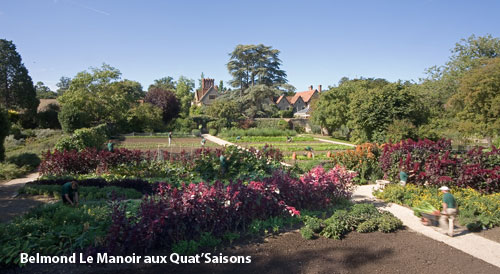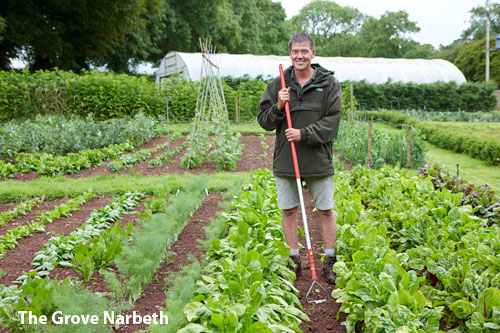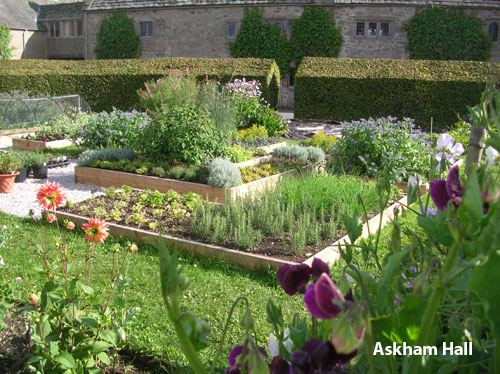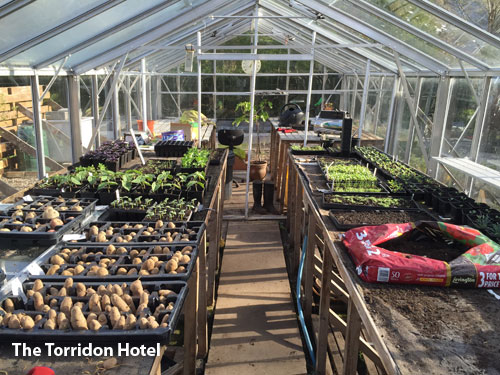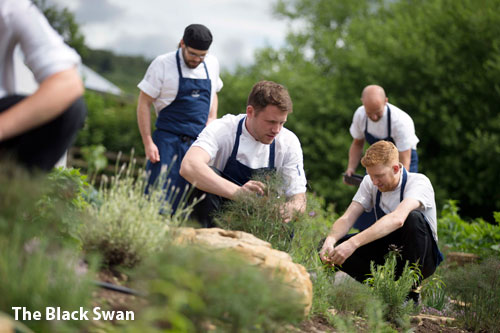How to get the most out of a kitchen garden
Kitchen gardens are an integral part of many brands and enhance the guest experience, but can you really see a return on investment? Stephanie Sparrow digs deep
More than 32 years ago, Raymond Blanc spotted an overgrown vegetable garden at the back of what was to become Belmond Le Manoir aux Quat'Saisons. Three decades later not only has he, with head gardener Anne Marie Owens, developed the plot to include more than 90 herbs and 250 varieties of vegetables, but the kitchen garden concept which he helped re-awaken in the popular consciousness has been developed at all sizes and styles of properties nationwide.
Kitchen gardens are not just found in lush countryside. Urban gardens, popular among city centre gastropubs and at community initiatives such as the Incredible Edible Beer Garden at Ramsbottom's Eagle & Child pub
are also increasing. Their number looks to grow further, thanks to this April's pledge from AccorHotels to plant 1,000 vegetable gardens in its hotels worldwide by 2020.
Arnaud Herrmann, sustainable development director of AccorHotels, says that the vegetable garden project is part of the group's Planet 21 programme, which promotes local growing as "less polluting, low energy and
low-carbon". Hotels will be encouraged to sow their own high added-value herbs and edible flowers, he says. Aesthetics are also a consideration. "Urban vegetable gardens make cities more beautiful," he adds.
Despite the allure of a kitchen garden, and its potential to cut food miles, they can struggle to earn their keep. The manpower required adds to the wages bill, while spending on irrigation or polytunnels means that a garden
can drain finances and staff time simply for the sake of growing what are still the cheaper menu items, compared to meat and fish.
Another consideration is the potential for friction between kitchen and garden staff if crops are late, in short supply or glut (piles of unused crops upset gardeners, and food waste harms eco credentials). The kitchen may work
more slowly when preparing muddy crops, while some young chefs lack the confidence to handle irregularly shaped heritage vegetables, no matter how sweet they taste. And to cap it all off, gardening is fighting a skills shortage, as more than a third of trained horticulturalists are over 50. (Some operators, like Chewton Glen, have already responded by running apprenticeships in horticulture, says estate manager Darren Venables.)
Bringing energy
And yet, even when all these pressures are taken into account, a kitchen garden offers potential. It brings energy to a property. It can inspire more regional and seasonal menus, and memorable marketing. For example,
kitchen gardens are so synonymous with the Pig brand of hotels that it wasn't a surprise to see senior kitchen gardener for the group, Ollie Hutson, competing at this year's Royal Bath & West Show. Meanwhile, the kitchen
garden at Gravetye Manor in East Grinstead is so high profile that the holding message for telephone callers is a recording by head gardener Tom Coward. At Chewton Glen, managing director Andrew Stembridge jokes
Chewton Glen is responding to its guestsâ enthusiasm for food and growing by adding a second kitchen garden. It will be part of a new £2.5m development of a cookery school and greenhouse, and the three elements will
work together when they open in November, says Stembridge. âVisitors will be able to learn about the produce they are preparing,â he says. Further North, at the four-red-star Rudding Park hotel near Harrogate, managing
director Peter Banks says that acknowledging that a kitchen garden can have lots of different uses within the business will help it pay its way. Two years ago he created an acre garden there with 52 raised beds. It is not just
as a food production area that contributes to the two-AA-rosette Clocktower restaurant, but also a guest destination. As such, it has its own marketing material and map.
âAs a venue we are looking at a 15-20 year payback,â he says. âAs a garden, it probably breaks even, after wage costs and seeds, even though it supplied around £25,000 of produce last year.â
Crops which would be expensive or difficult to source from suppliers, and which occupy small amounts of space, are another step to financial viability. For Banks the answer was edible flowers, along with herbs, salad leaves and heritage beetroots.
âWe can get 20 covers out of a punnet of edible flowers which would cost us £1 a punnet to buy. We recently did 900 covers on one night in May, and so growing our own makes sense,â he says.
A keen amateur horticulturalist, Banks balances his passion with pragmatism: âEvery single bed needs to tell a story and be useful,â he says. âIf it doesnât, then itâs just vanity.â You will get the best from your garden if
you initiate regular dialogues between chef and gardener, and encourage a flexible attitude from the chef to consider menu alternatives, says Allister Barsby, executive chef at three-AA-rosette restaurant the Grove Narberth.
Barsby, who has access to 70 varieties of vegetable, herbs and summer fruits from the one-acre kitchen garden in Pembrokeshire, says that being open-minded can help with food costs.
âSometimes you canât be too precious,â says Barsby. âA recipe might mention celeriac, but if youâve got baby fennel, then why not make that work? If you communicate effectively you can cut food costs. We aim for 25% of food costs in the summer, and 30% in the winter, which is below the industry norm of 28%-30 % for fine dining,â he says.
At Gravetye Manor, head chef George Blogg and head gardener Coward confer regularly about seed orders and a wish list of produce.
Later in the season Coward gives Blogg a âpredicted croppingâ diary to help plan menus, and during harvests Blogg gets a daily list about what he âcan haveâ and âmust haveâ. The latter must be accommodated to avoid gluts.
Blogg sees the benefits of this regime. âIncorporating seasonal produce into a menu gives them clout and soul,â he says.
Chefs can turn gluts into a benefit, says chef-turned-grower Ross Geach. Geach, who worked for Rick Stein, now runs Padstow Kitchen Garden. âUse the specials board,â he says, âand try pickling and preserving.â Pig
Hotels has an even more novel answer â" it dried a surfeit of chillies and hung them as Christmas decorations, says Hutson.
However, few operators would claim to be self-sufficient. All advise buying cheaper staples from suppliers because they are not cost effective to grow. But do not discount a gardenâs potential for innovation â" either to try new vegetables (Hutson is talking to a specialist supplier about the viability of Ulluco tubers from the Andes), or to revive heritage varieties.
Rooftop gardens neednât miss out either. Urban specialist Tom Moggach, who advises caterers through his City Leaf consultancy, says that little space is needed to grow fashionable herbs such as Japanese green shiso. âIt can be grown in the same way as basil, and has a lot of potential,â he says.
Heritage varieties are of particular interest to Richard Swale, head chef at Askham Hall in Ullswater in the Lake District. Cumbrian-born Swale is proud of his Hispi cauliflowers and varieties of fruit. âAnd Iâm pleased that medlar is coming back into fashion,â he says. âWe serve it with pork or make medlar jelly. Growing our own produce certainly inspires us and our customers, who regard visiting the kitchen garden before the sitting down in the restaurant as a whole package.â
Swale also advises that the kitchen and gardening staff eat the homegrown produce.âThat way everyone can discuss the journey from seed to plate, something that is missing in education.â
This is the ultimate, but unquantifiable benefit of a garden: to engage staff and guests, as well as ensuring that operators can soothe 21st-century angst. As Banks from Rudding Park says: âMy theory is that guests, who probably spend all their working week with technology, want to feel that they are in touch with something growing.â
Digging deep at the Torridon Hotel
Kitchen gardens are a labour of love, particularly among the wet, stony terrain of the north west Highlands of Scotland, but it is still worth digging deep to enhance the guest experience. This is the opinion of Dan Rose-Bristow, managing director of the Torridon Hotel in Wester Ross. His kitchen garden sits in two acres at the 18-bedroom Pride of Britain property and contributes to the menu at the three-AA-rosette restaurant and 12-bed inn. But it has not replaced the thrice-weekly vegetable deliveries from suppliers, which Rose-Bristow says are needed to service the 250 daily covers.
âThere is little return for the cost of a kitchen garden, but it helps us up-sell, in that it adds to the value and culture of what we do around the property,â says Rose-Bristow.
As a safeguard against the elements, a £10,000 greenhouse and £5,000 polytunnel have been installed, along with 15 cold frames to bring on fruit, herbs and vegetables under cover.
Again, Bristow thinks it is worth the spend. âOur garnishes, salads, and desserts, such as lemon verbena sorbet, are popular with customers who see the added value and effort and enjoy discussing the provenance of their food. It also enables us to engage with them on social media.â
Head chef David Barnett is similarly engaged. He compiles an annual wish list for the gardeners in advance of the sowing season and briefs them regularly about the success of the produce. He is helping Rose-Bristow
to evaluate the potential of hydroponics for baby leaf and microherbs. Hydroponics will not just be a tactic to beat the weather, but also a chance to keep developing the menu.
Growing a new menu and lifestyle at the Black Swan at Oldstead
In 2014 when chef Tommy Banks decided to create a kitchen garden in a spare field at the back of the Black Swan at Oldstead, it was the catalyst for change. Banks replaced the French-influenced menu with one which reflects the restaurantâs rural setting.
âOur business is now led by what we grow and forage,â he says. There is plenty of evidence of this at the North Yorkshire property, where the 40-cover restaurant might serve homegrown crapaudine beetroot slow-roasted in beef fat.
Banksâ nine chefs double as gardeners and foragers and are likely to start their working day with birdsong rather than the clatter of knives ringing in their ears. One shift a week might comprise an entire day in the garden.
âI took a gamble to close at weekday lunchtimes so that chefs could work in the garden and fulfil my ethos,â says Banks. He has been vindicated by a busy restaurant in the evening and a re-energised brigade.
His 2.5 acre garden, which was developed in August 2014 with advice from his father and specialist grower Ken Holland, is largely dedicated to high-value produce. It includes a propagation tunnel where unusual crops such as oyster leaf are cultivated.
âOyster leaf is around £7.50 for 50 leaves, or 15p per leaf. Most people would serve three or four to a plate. I have so many that I blend them into oil to make a mayonnaise.â
Staff appreciate the fresh air and learning opportunities.âI am learning all the time and since I have been involved in growing and harvesting, I have gained respect for fresh ingredients,â says senior sous chef de partie Ryan Darley.
Get the best from your herb and kitchen gardens
Horticulturalist Peter Earl is a fruit and vegetable expert at RHS Rosemoor, Devon, where he also supplies its Garden Kitchen restaurant. Bryone Dillow is currently replanting the one-acre herb garden at Congham Hall, the three-redstar hotel in Norfolk. Here are their top tips for gardens:
- Make sure that you have enough human resource to plant, maintain and harvest your crop. Never underestimate the knowhow and time and money that you might need
- Know your soil (acid or alkali) and your site before you select seeds. Is it windswept or sheltered, for example?
- Include paths in your garden design to ensure that you have room to tend your plants.
- Use the garden as an opportunity to grow obscure crops or herbs, such as sorrel, which you cannot obtain easily, rather than common vegetables.
- This is your chance to serve produce with minimal waste. If a chef and gardener communicate, then you can avoid a glut of unwanted food.
- If a glut does occur, then turn it into an opportunity for pickling and preserving.
- Think fresh and serve fresh. You and your menus will benefit if you are aware that some vegetables, such as sweetcorn and chard, are best served straight after picking.
- Plant herbs in the ground rather than pots, wherever possible. If pots are your only option, then ensure that they are well-drained by putting sand or stones at the bottom. Roots must not get soggy.
- Herbs require an amount of maintenance and watering. You might be tempted to use them in a roof-top garden, but be sure that you have easy access to a water supply.
- Pick herbs regularly to prevent them going to seed.



